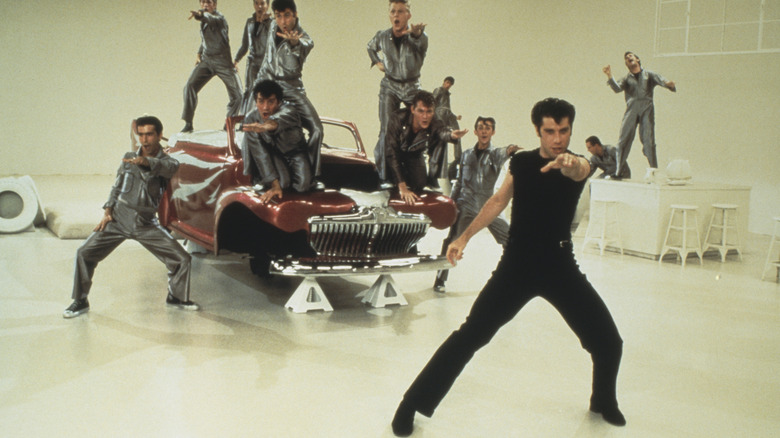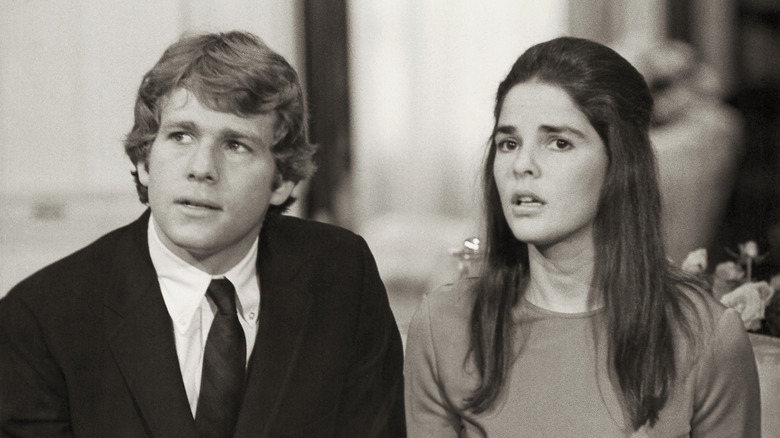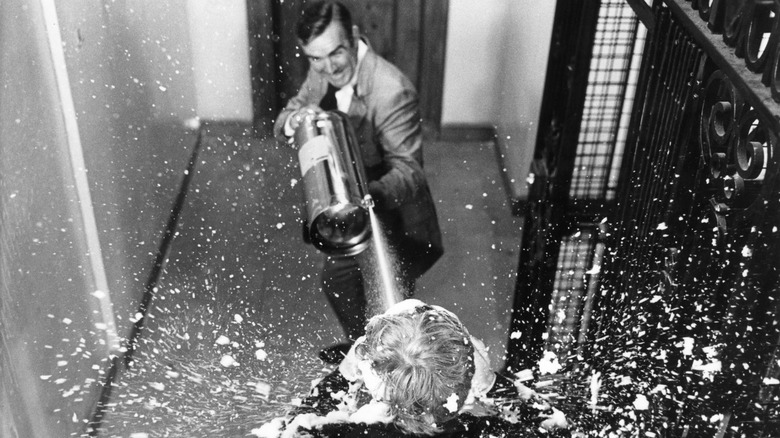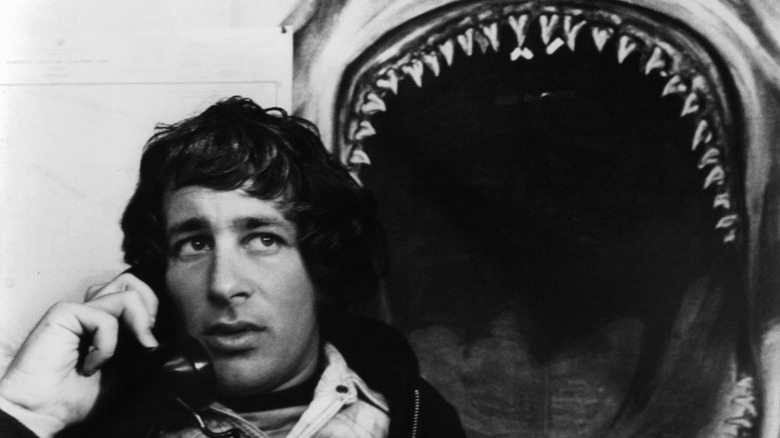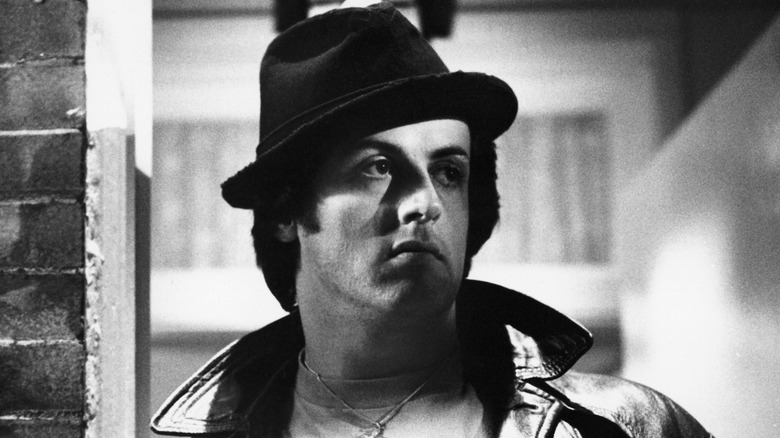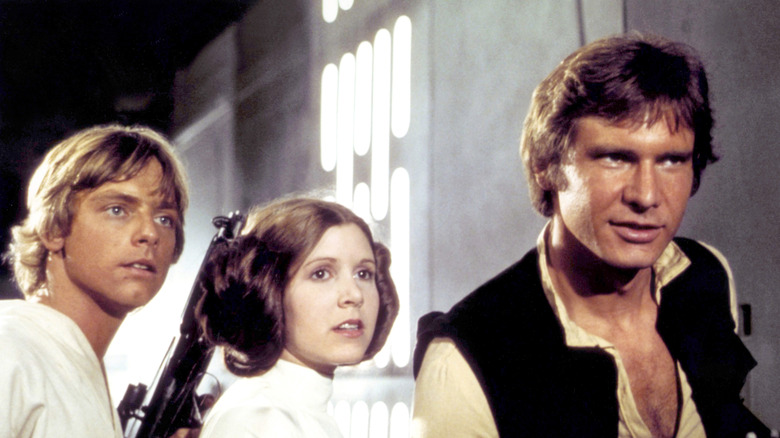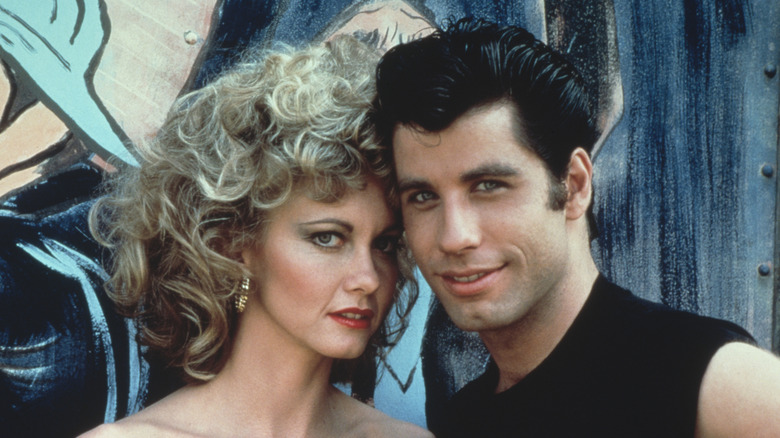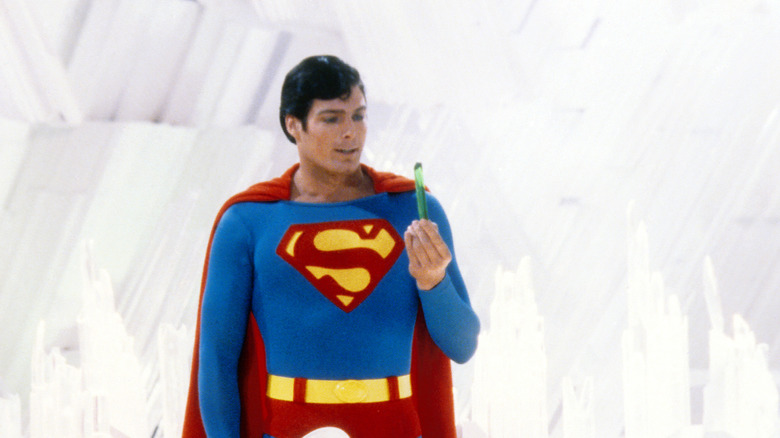The Most Popular Film From Every Year Of The 1970s Explained
What an explosive decade the 1970s turned out to be for historic filmmaking. You can't throw a dart at the calendar of any year without hitting some classic title that helped form the art of cinema. These movies also ended up making incredible revenue for the studios that produced them and launched some of the best-known figures in the industry into the careers they now enjoy. For viewers, they're also peak creations that new audiences find again and again, discovering just how rich this cinematic age really is.
There was no shortage of diversity in the films being made back then. Classic horror titles were taking huge risks and delivering thrills no audience had ever encountered. Disaster flicks set pulses racing and introduced viewers to the idea of super-sized, effects-laden blockbusters. Musicals were setting records, romances were setting hearts racing, and superhero adventures were setting new standards for how convincing filmmaking could be.
Pulling back the curtain on the biggest films in each year of the 1970s reveals intriguing behind-the-scenes happenings and industry insider goings-on that make the lore of these movies even more fascinating. From the instant chemistry of the "Love Story" stars to the lofty financial demands made by the most famous actor in "Superman: The Movie," here's a look at the inner workings and cinematic success of the biggest films of the disco decade.
1970: Love Story
Ali McGraw and Ryan O'Neal prove love means never having to say you're sorry in what was unanimously considered the tearjerker of the decade. Everything from the Oscar count (seven nominations, one win for Best Music) to the $136 million worldwide take said these doomed lovers were destined for cinema history. The road to romance is never easy, but for these poor lovestruck kids, it was thoroughly disastrous.
Luckily for the filmmakers, there was chemistry between McGraw and O'Neal from the start. The two leads found sparks despite having little in common. As "We had absolutely nothing in common," McGraw told People during the film's 50-year anniversary in 2021. "He was a California kid, had been a movie star, was athletic." Still, the two found what they needed to make their onscreen romance blossom. "It was magic," O'Neal concurred.
The filming didn't come without its challenges, however. To prepare for their roles, McGraw had to learn to play the harpsichord, while O'Neal took ice skating lessons to appear proficient onscreen (via Parade). There were also setbacks with the location; Harvard wasn't too pleased with the production on its campus and kicked the crew off their ivy league lawns after a week, closing down nearly all future commercial filming. Ironically, the university still hosts a showing of the tragic romance for incoming freshmen every year.
1971: Diamonds Are Forever
As a peak James Bond entry with the timeless Sean Connery donning the tux once again to play 007, "Diamonds Are Forever" is a memorable addition to the spy's multi-generational canon. Connery was a major get in his return to the role; after Bond actor George Lazenby turned it down, Burt Reynolds, Clint Eastwood, and Robert Wagner were floated as replacements. But a Guinness World Record-setting contract worth $1.25 million was enough to lure Connery back into the agent's famous Aston Martin. That figure caused the effects budget to be scaled back (per IMDb).
In this outing, Bond joins up with a diamond-smuggling ring to stop international villain Blofeld from deploying a lethal space laser. Despite the incredible wealth on display, the spy life isn't as glamorous on film as it may be portrayed. To capture the mud bath texture for the film's opening scene, the effects crew used instant mashed potatoes, which proceeded to cook in the extreme heat of the set lights over the course of a 20-hour set-up. And yes, Connery and co-star Jill St. John were romantically involved in real life.
You may recognize some of the power players also making waves that year. Billy Jack, which was released in January of 1971, actually grossed the most domestically that year, and "The Last Picture Show," "A Clockwork Orange," and "Fiddler on the Roof" all flexed their vastly varied cinematic muscles. But this diamond shone brighter than all the others. While it was released in December of 1971, "Diamonds are Forever" raked in $116 million worldwide, according to The Numbers, against a $7.2 million budget, it was an undeniable blockbuster.
1972: The Godfather
All film buffs know that "The Godfather" is arguably the best mafia movie ever made, thanks to Francis Ford Coppola's deft portrayal of the Corleone family and its complex dynamics. But the behind-the-scenes intrigue practically rivaled the story's power struggle and themes of betrayal, thanks to oversized egos that make Hollywood a hotbed of on-set controversy.
Though it embedded Al Pacino's Michael Corleone in film culture as one of the most memorable characters ever, viewers may not realize it was one of his first films. His bosses realized it, though, and because of his understated performance, Al Pacino nearly lost his star-making role. And of course, Marlon Brando was Don Vito Corleone forevermore from the moment he appeared onscreen. But the troublesome Brando was considered difficult to work with and wasn't the actor Paramount Pictures wanted for the role. Similarly, in over his head as director, editor Aram Avakian was thought to be scheming to oust Coppola and take over but was fired instead — a behind-the-scenes plot twist!
Other high performers for 1972, like "The Poseidon Adventure," "Deliverance," and "Cabaret" brought diverse storytelling to the cinema landscape, but The Godfather captured the souls of audiences enough to become the biggest film of the year. It's $250 million worldwide take also made it the highest-grossing film of all time in 1972.
1973: The Exorcist
If the makers of "The Exorcist" learned anything about making a film depicting demonic possession, hopefully it was that tinkering with evil themes may create a cursed production. At least the string of strange accidents, injuries, and murderous activity that plagued the cast and crew points to something sinister percolating under the surface.
The modern classic about a 12-year-old girl being overtaken by a demon and terrorizing the priests who try to exorcise it, "The Exorcist" was a graphic masterpiece that had audience members fainting in the aisles. The arduous, stunt-filled filming resulted in back injuries for both Linda Blair and Ellen Burstyn, who played the possessed girl's beleaguered mother. A fire nearly decimated the MacNeil house set, closing production for several weeks. And in 1977, actor Paul Bateson, who had a small role as an X-ray tech, was found guilty of murdering a film critic and was sentenced to 20 years to life in prison.
Whatever the truth about "The Exorcist" curse might be, no film set the horror world on edge more than this 1973 classic. It's still considered by many to be one of the scariest films ever created, with new sequels expanding the demonic universe. Competing works like "The Way We Were," "The Sting," and "American Graffiti" were all tame by comparison, which may be why it hauled in $193 million at the box office, making it the year's highest performer. Not bad for a cursed production.
1974: The Towering Inferno
Disaster movies became de rigueur in the '70s, and few had a bigger impact on the viewing public than "The Towering Inferno." The simple plot — people try to escape a deluxe modern skyscraper as it goes up in flames — left plenty of space for melodrama and a host of characters to prove their determination to survive. With names like Faye Dunaway, Paul Newman, Fred Astaire, and Steve McQueen on the marquee, it was a flashy, splashy popcorn movie that did exactly what it was meant to do: make money.
Producer Irwin Allen had already sharpened his skills with disaster films on 1972's "Poseidon Adventure" when he decided to shift away from water disasters to tackle an enormous building fire instead. According to Hollywood Reporter, the massive production took up 57 sets on 20th Century Fox's largest soundstages. Newman and McQueen both received $1 million salaries (nearly $7 million when adjusted for inflation). And in a sweet piece of Hollywood lore, Steve McQueen's onset behavior included jumping in to help actual firefighters when the flames raged out of control and caused an actual fire on the set (per IMDb).
The film shared the year with "Earthquake," "Chinatown," and "The Godfather: Part II," all of which made indelible marks in the world of film. Racking up eight Oscar nominations and winning three, while bringing in $139 million worldwide. "The Towering Inferno" became the second-highest grossing film of 1974, losing top spot to "Blazing Saddles." Apparently, it was a banner year for fire-themed film titles.
1975: Jaws
The movie that launched the concept of the summer blockbuster, "Jaws," was more than just 27-year-old director Steven Spielberg's second feature film. It was also a cultural juggernaut that made beachgoers genuinely afraid to go into the ocean. When a film has the power to alter the leisure time habits of viewers, you know you've hit paydirt.
The tale of the massive great white shark chomping on unsuspecting swimmers and the ragtag team of heroic everymen who head out to sea to stop it, "Jaws" took place on the fictitious Amity Island, but it was actually filmed on Martha's Vineyard. Instead of taking the scheduled 65 days to finish shooting, weather issues and technical problems — some with the mechanical shark in the starring role — dragged the filming out to 159 days instead. The budget ballooned, more than doubling from the original $4 million to $9 million (per Amblin).
All of it seemed to be worth the time and trouble when "Jaws" became one of the highest-grossing films ever, pulling down a vault-breaking $497 million worldwide on its initial release alone. Though it shared the top ten with masterworks that include "Dog Day Afternoon," "One Flew Over the Cuckoo's Nest," and "Rocky Horror Picture Show," among others, the film about the killer shark chewed up the competition.
1976: Rocky
Sylvester Stallone created an unforgettable character when he became Rocky Balboa in "Rocky," which featured a screenplay written by Stallone himself. The studio offered him several huge chunks of money to step aside and let a bigger name actor star instead. But Stallone was so set on playing Rocky himself, he ultimately turned down $325,000 and took a $35,000 salary instead. As the saying goes, the rest is history.
The story of Rocky's tenacity matched the story of Stallone's determination, often resulting in heartbreaking decisions Stallone had to make before he became famous. He worked odd jobs in NYC before he found a studio to produce his screenplay, and he'd even had his sights set on a part in "The Godfather" — perfect for an actual Italian, he thought, though obviously he didn't get it (per ABC News). When Stallone ended up writing the "Rocky" script in three and a half days, he found a new angle into the filmmaking game and created an iconic cinematic legacy.
The year was thick with big films, all-time greats like "A Star is Born," "Bad News Bears," "Carrie," and "Taxi Driver." But at $117 million, none did better at the box office in 1976 than "Rocky," which also walked away with Oscars for Best Picture, Best Editing, and Best Director. It also made the steps to the Philadelphia Museum of Art world famous.
1977: Star Wars: Episode IV - A New Hope
The sleeper space opera hit that would launch George Lucas into movie mogul status, "Star Wars: Episode IV – A New Hope," was called simply "Star Wars" when it was released. Despite Lucas' belief that his film would actually bomb, it launched an unending love affair with a scrappy crew of galactic fighters battling the evil empire. No matter how far new works stray from the original canon, we just can't hate Star Wars.
The cast you know and swoon over was assembled with a great deal of searching. Harrison Ford was recycled from Lucas' "American Graffiti" to become the iconic Han Solo. Express reported that Carrie Fisher was up against Meryl Streep, Jodie Foster, Farrah Fawcett, and a pre-Ripley Sigourney Weaver for the part of Princess Leia. And Kurt Russell vied with Freddy Krueger himself, Robert Englund, to become Luke Skywalker, according to People.
The other beloved space film of 1977, "Close Encounters of the Third Kind," helped lock in the Spielberg-Lucas blockbuster connection that produced one of cinema's most prodigious power team. While on vacation in the year their films were released, the two auteurs began spit-balling an idea that would become one of their next films, a little gem called "Raiders of the Lost Ark."
In terms of money, the $11 million budget was more than recouped by the staggering $307 million box office income. Adjusted for inflation, the figure would be in the neighborhood of $1.6 billion.
1978: Grease
The '70s were ripe for mid-century nostalgia, and audiences received it in the form of "Grease." Based on a 1972 Broadway musical, the nostalgic story of star-crossed high school lovers made the '50s feel fresh and edgy, even though all the "teens" were well into adulthood.
Casting was a key win here. John Travolta, who'd played the character Doody in the Broadway production, graduated to the lead role of Danny Zuko, pretty slick for a 23-year-old sitcom star. And though it's difficult to imagine anyone better than Olivia Newton-John as Pollyanna-to-bombshell Sandy Olsson, it took a fair amount of convincing to get the singer to sign up. Her main concern? Being 29 years old at the time of filming as a high-school senior, and not having an American accent. Once Travolta visited her Malibu home to convince her, the call was cast.
The soundtrack was as much a phenomenon as the movie, a best-seller boasting two brand-new chart-topping songs written especially for the movie. Newton-John's ballad, "Hopelessly Devoted to You," reached No. 3 on Billboard's Hot 100, while the rollicking duet "You're the One That I Want" made it all the way to No. 1. Both songs became standards for Newton-John, and the film turned into the template for future stage productions.
In a year where "Animal House," "Jaws II," and "Halloween" competed to capture filmgoer funds, "Grease" grossed a phenomenal $159 million worldwide in 1978. Box Office Mojo shows Grease at $77,098,600 as a life-time haul, making it the 28th highest grossing film of all time; among musicals, only "Mary Poppins," "The Lion King," and "The Sound of Music" have grossed more.
1979 – Superman: The Movie
Admittedly, there are huge mistakes that DC won't be able to come back from. But the 1979 film that became the blueprint for the blockbuster superhero movies that came afterward isn't one of them. "Superman: The Movie" was the first convincing comic book flick that felt authentic. It was advertised with a tagline that promised, "You'll believe a man can fly" — and we did ... and it was all done decades before CGI would make flying metahumans a mostly digital experience.
Bringing the film to market came with monumental hurdles, including a wonky, oversized script and an extra $25,000 needed to fund the flying effects. The budget included $3.7 million for Marlon Brando, who also received almost 12% of the profits — all for 13 days of work and just about 20 minutes of screen time (per Variety). Christopher Reeve, who was a tall and thin 23-year-old Juilliard graduate acting in only his second film ever, underwent the first superhero body transformation workout regimen to add 30 pounds of muscle to fill up the suit. And choosing the perfect Lois Lane meant screen testing a slew of actresses, including Lesley Anne Warren, Stockard Channing, and Anne Archer, before Margot Kidder was booked for the iconic role.
Big Blue had stiff competition from other big films released that year; "The Amityville Horror," which also starred Margot Kidder, "Apocalypse Now," "Rocky II," and "Star Trek: The Motion Picture" all pulled in bags of cash at the box office. Ultimately, the Kryptonian prevailed as the highest grossing film of 1979, with a total take of $134 million worldwide.
